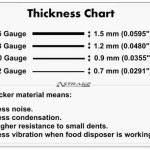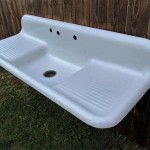Standard Depth of Kitchen Sink
The depth of a kitchen sink plays a crucial role in its functionality and overall user experience. While aesthetics and style are important considerations, the sink's depth significantly impacts its practicality for everyday tasks such as washing dishes, filling pots, and cleaning large items. Understanding the standard dimensions, including depth, can help homeowners make informed decisions during kitchen renovations or new builds.
The standard depth for a kitchen sink typically ranges from 8 to 10 inches. This measurement refers to the distance from the top rim of the sink to the bottom of the basin. Sinks within this range offer a balance between usable space and ergonomic comfort. Shallower sinks, while potentially offering more accessibility for some users, may lack the capacity to accommodate larger pots and pans or prevent splashing. Conversely, excessively deep sinks can strain the user's back and shoulders during extended use.
Several factors influence the ideal sink depth for a specific kitchen. The height of the countertop is a primary consideration. A lower countertop generally pairs well with a deeper sink, while a higher countertop may benefit from a slightly shallower sink to maintain comfortable reach. The user's height also plays a role. Taller individuals might find deeper sinks more comfortable, while shorter individuals might prefer shallower options to avoid overreaching.
Beyond the standard 8-10 inch range, various sink depths exist to cater to different needs and preferences. Farmhouse sinks, known for their apron-front design, often feature deeper basins, sometimes exceeding 10 inches. These deeper basins provide ample space for soaking and washing large items but might require careful consideration of countertop height and user ergonomics. Conversely, some modern and minimalist sink designs opt for shallower depths, sometimes as little as 6 inches. These sinks can offer a sleek, contemporary look but might sacrifice some practicality for users accustomed to deeper basins.
The material of the sink can also subtly affect the perceived and usable depth. Thicker sink materials, such as cast iron, can slightly reduce the internal basin dimensions compared to thinner materials like stainless steel. While the nominal depth might be the same, the actual usable space can differ slightly due to the material thickness.
When selecting a kitchen sink, considering the available space beneath the countertop is crucial. Deeper sinks require more vertical space under the counter, potentially impacting plumbing configurations and storage options. Careful planning and measurement are necessary to ensure the chosen sink depth fits comfortably within the available space without interfering with pipes, garbage disposals, or other under-sink components.
The type of faucet chosen can also influence the effective depth of the sink. High-arc faucets provide more clearance between the faucet and the sink bottom, accommodating taller pots and pans. Low-arc faucets, while aesthetically pleasing in some designs, can limit the height of items that can be comfortably filled or washed within the sink. The relationship between faucet height and sink depth should be considered during the selection process to optimize functionality.
Beyond the primary function of washing dishes, the kitchen sink often serves multiple purposes. It's a common location for food preparation tasks, such as rinsing vegetables and filling pots. A deeper sink can simplify these tasks by containing splashes and accommodating larger quantities of food. The depth also affects the ease of cleaning the sink itself. Deeper sinks can sometimes make it more challenging to reach the bottom for cleaning, requiring longer-handled brushes or tools.
In addition to standard undermount and drop-in sinks, integrated sinks, which are seamlessly molded with the countertop material, offer another depth consideration. These sinks often feature consistent depth throughout the basin, eliminating the lip or rim found in traditional sinks. This seamless design can enhance aesthetics and simplify cleaning but requires careful consideration of the overall depth and its impact on functionality.
Ultimately, the optimal kitchen sink depth depends on individual needs and preferences. While the standard 8-10 inch range offers a good starting point, considering factors like countertop height, user height, faucet type, and intended usage can help homeowners select a sink that balances functionality, ergonomics, and aesthetics. Careful planning and consideration of these factors contribute significantly to a comfortable and efficient kitchen workspace.

A Simple Guide To The Kitchen Sink Size Chica Dragon

Dimension Of Kitchen Sink Standard Sizes In India Best S

Standard Size One Bowl Kitchen Stainless Steel Sink 800 500mm China Basin Water Tank Made In Com

Dimension Of Kitchen Sink Standard Sizes In India Best S

Reginox Minister Large Bowl Reversible Stainless Steel Kitchen Sink Tap Pack Selco

American Standard Raviv Stainless Steel 32 In Double Bowl Drop Kitchen Sink 18db000132c2 075
Kitchen Sink Ing Guide Signature Hardware

How To Choose Your Kitchen Sink Size A Definitive Guide

Have A Question About American Standard Raviv Stainless Steel 33 In Single Bowl Drop Kitchen Sink Pg 0 The Home

American Standard Tamarind Stainless Steel 33 In Double Bowl Drop Kitchen Sink With Semi Pro Faucet 18db000132c3 075







